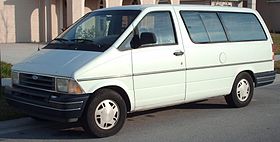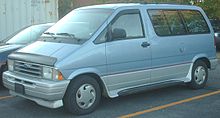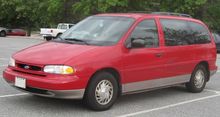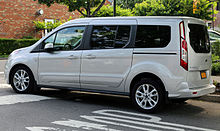Ford Aerostar
| Ford Aerostar | |
|---|---|
 1992–1996 Ford Aerostar | |
| Overview | |
| Manufacturer | Ford |
| Production | June 15, 1985 – August 22, 1997 |
| Model years | 1986–1997 |
| Assembly | Hazelwood, Missouri (St. Louis Assembly) |
| Body and chassis | |
| Class | Minivan |
| Layout | |
| Platform | Ford VN1 platform |
| Powertrain | |
| Engine | 2.3 L Lima
I4 (1986-1987) 2.8 L Cologne V6 (1986) 3.0 L Vulcan V6 (1986-1997) 4.0 L Cologne V6 (1990-1997) |
| Transmission | 5-speed manual 4-speed automatic 5-speed automatic |
| Dimensions | |
| Wheelbase | 118.9 in (3,020 mm) |
| Length | Standard-length:174.9 in (4,440 mm) Extended-length:190.3 in (4,830 mm) |
| Width | 71.7 in (1,820 mm) |
| Height | 72.2–74.0 in (1,830–1,880 mm) |
| Chronology | |
| Successor |
|
The Ford Aerostar is a range of passenger and cargo vans that was manufactured and marketed by Ford in the United States and Canada; a limited number were exported outside of North America. The first minivan sold by Ford, the Aerostar was sold in a single generation from the 1986 to 1997 model years. Introduced shortly before the Ford Taurus, the vehicle derived its nameplate from its slope-nosed "one-box" exterior (although over six feet tall, the body of the Aerostar retained a drag coefficient of Cd=0.37,[1] besting the LINCOLN Mark VII).
For the 1995 model year, the front-wheel drive Ford Windstar was introduced to replace the Aerostar; both minivans were sold concurrently through the 1997 model year. In the Ford model line, the role of the Aerostar cargo van was left unfilled; the closest successor is the Ford Transit Connect, introduced in 2010.
A total of 2,029,577 Aerostars were produced from 1985 to 1997. All production was sourced from the now-closed St. Louis Assembly Plant in Hazelwood, Missouri.
Development[edit]
Carousel: the garageable van[edit]
At Ford, development of a minivan began in the early 1970s, starting life as a companion model to the third-generation Ford Econoline/Club Wagon.[2][3] As its full-size van was slated to grow in size for its 1975 redesign, Ford explored the concept of a "garageable van", using a roofline with a height to easily fit through a typical garage door opening. Additional objectives for the vehicle would include increased interior space over station wagons and more attractive styling over full-size vans.[3]
Dubbed the Ford Carousel, a prototype was tested from 1972 to 1974.[2][3] To achieve its "garageable" status, its roofline was lowered approximately 12 inches in comparison to a standard-wheelbase Ford Club Wagon (placing its height close to that of the Ford Windstar/Freestar). Along with restyled A-pillars and a completely new front fascia, the Carousel received a wagon-style roofline (with wraparound window glass); in a key indication of its future as family-oriented vehicle, the Carousel wore a rear tailgate with a drop-down rear window with simulated exterior woodgrain trim. Inside, it was fitted with two rear bench seats with interior trim similar to the Ford Country Squire and Mercury Colony Park.
While the Ford Carousel received a positive response by many Ford executives for a potential 1976 introduction, it ultimately would not reach production.[3] While financial constraints forced the company to divert funds towards critical projects (such as the Fox platform and Panther platform), the 1973 energy crisis played a major role as well (the prototype was fitted with a 460 V8, shared with full-size Ford vehicles and one-ton Ford trucks[4]).
In 1978, Lee Iaccoca and Hal Sperlich both departed Ford and were hired by Chrysler; the Chrysler minivan project was approved by the end of 1979. While adopting the basic "garageable van" concept of the Ford Carousel prototype, the resulting 1984 Dodge Caravan and Plymouth Voyager were far different vehicles in terms of layout and engineering.
Aerostar: all-new design[edit]
During the early 1980s, as the American automotive industry learned of the development of the Chrysler minivans, Ford commenced development of its own vehicle in response. The energy crises of the late 1970s had made fuel economy a high priority of vehicle design; as such, producing the Ford Carousel (downsizing the Ford Club Wagon to a lower height) would not be a competitive option for Ford.
While using the 6-foot height of the Carousel as a starting point in concept, the 1980s Ford "garageable van" was a completely clean-sheet design. In a major shift, the new design shifted mechanical commonality from full-size trucks and vans to the compact Ford Ranger in an effort to reduce weight. In what would be a major break from the Chrysler and GM minivans, the Ford minivan received a distinct chassis (with model-specific front and rear suspension).[5] To further improve fuel economy, Ford added a number of lightweight materials for the body, using plastic bumpers, fuel tanks, liftgate doors, and hoods; aluminum was used for the driveshaft, axles, and wheels.[5]
In 1984, the Ford Aerostar name was first used as Ford unveiled a concept vehicle previewing the final production minivan.[6]
Overview[edit]
Chassis[edit]
As with its Chrysler and General Motors minivan counterparts, the chassis of the Ford Aerostar derived a number of suspension and powertrain components from existing vehicles to lower development costs. Although it would become the first Ford truck to make use of a unibody chassis, the Aerostar shared most of its components with the Ford Ranger/Bronco II light trucks. To reinforce the chassis for towing and overall rigidity, the dedicated platform (codenamed VN1, the first alphanumeric designation for a Ford platform) was designed with full-length integrated frame rails. The addition provided the Aerostar with the same 5,000 pounds (2,300 kg) tow rating as the Chevrolet Astro/GMC Safari, and 2½ times the capacity of the Chrysler minivans.[6][7]
The front suspension consisted of unequal length A-arms through its entire production; for 1990, the lower A-arm was revised to accommodate the addition of all-wheel drive as an option. The Aerostar differed from all other Ford light trucks in its rear suspension configuration as well. To save space, the live rear axle was fitted with a three-link coil-sprung rear suspension (similar to the Panther-platform cars of the time)[5]. During its production run, the Ford Aerostar was the only North American-market minivan sold with four-wheel coil-spring suspension (the planned launch of the Renault Espace by AMC was stillborn).
While the planned four-cylinder diesel engine from the 1984 concept vehicle was dropped in the prototype phase,[6] the Aerostar was launched with two engines from the Ranger/Bronco II: a standard 2.3 L four-cylinder (shared with the Mustang) and a carburetor equipped 2.8 L Cologne V6 (from Ford of Europe) for the first few months of production. Shortly after the introduction, the 2.8L V6 was replaced with the newly introduced electronic multi-port fuel injected 3.0 L Vulcan V6 from the Ford Taurus/Mercury Sable,[8] adding 30 hp. For 1988, the 2.3 L engine was discontinued; the Aerostar became the first minivan powered exclusively by V6 engines. In 1990, coinciding with the introduction of the E4WD Aerostar, a 4.0 L version of the Cologne V6 was introduced; while standard with all-wheel drive versions, it became an option on rear-wheel drive XLT and Eddie Bauer trims as well.
Sharing its transmissions with the Ford light-truck line, the Aerostar was available with a five-speed manual until 1995 (nearly exclusively in cargo vans and XL trim); unlike the Chrysler minivans, the Aerostar was sold exclusively with overdrive automatic transmissions. In 1997, the 4.0 L V6 became paired with the first five-speed automatic transmission fitted in a US-market minivan.
| hide | |||||
|---|---|---|---|---|---|
| Engine name | Displacement | Horsepower | Years available | Notes | Transmissions |
| Lima inline-4 | 2.3 L (140 cu in) SOHC I4 | 100 hp (75 kW) | 1986–1987 | Shared with the Ford Ranger, Ford Mustang/Mercury Capri, and Ford LTD.
Also shared with Ford Mustang SVO and Ford Thunderbird Turbo Coupe (in naturally-aspirated configuration). |
5-speed manual
4-speed automatic 5-speed automatic
|
| Cologne V6 | 2.8 L (170 cu in) OHV V6 | 115 hp (86 kW) | 1986 | Shared with the Ranger and Bronco II, this engine was used only for the first few months of 1986 production.[8] The Aerostar was the last North American Ford to use this variant of the Cologne V6. | |
| Vulcan V6 | 3.0 L (182 cu in) OHV V6 | 145 hp (108 kW) | 1986–1997 | Shared with the Taurus/Sable and Tempo/Topaz, the Aerostar was the first rear-wheel drive application of the Vulcan V6.
The Vulcan V6 was the only engine for the 1988-1989 Ford Aerostar. | |
| Cologne V6 | 4.0 L (245 cu in) OHV V6 | 160 hp (119 kW) | 1990–1997 | Shared with the Ranger and Explorer, the 4.0L Cologne V6 was optional in rear-wheel drive versions and standard in all-wheel drive examples. | |
All-wheel drive (E-4WD) Aerostar (1990–1997)[edit]
For 1990, Ford introduced an electronically-controlled four-wheel drive system as an option for the Aerostar. Called E-4WD (Electronic 4-Wheel Drive), the system was specifically an all-wheel drive system. Using a Dana TC28 transfer case with a center differential (regulated by an electronically controlled electro-magnetic clutch), all four wheels were given traction at all times. The system shifted traction to the front wheels as it detected rear wheel spin, with no driver input required. As E-4WD was not intended for off-road driving, the Aerostar was not provided with specific low-range gearing.
Sold from 1990 to 1997, the E-4WD option was available with XLT and Eddie Bauer trims and was paired exclusively with the 4.0L V6 and automatic transmission.
Exterior[edit]
Distinguished by its sloped-nosed design, the Ford Aerostar utilized a "one-box" design similar to the Renault Espace and the Ford Transit; in contrast to its European counterparts, the Aerostar had much shorter overhangs with the wheels placed at the corners. In an effort to further improve its fuel efficiency and aerodynamics and lower its curb weight, several plastic body parts (bumpers, rear hatch) that were utilized in the 1984 concept car were adopted for production.
As a response to the Dodge Grand Caravan and Plymouth Grand Voyager, an (unnamed) extended-length version of the Ford Aerostar entered production for 1989. Sharing the 119-inch wheelbase with the standard-length version, the extended-length Aerostar added 14 inches to the rear body. During the 1990s, the extended-length Aerostar would become the most popular version of the vehicle.
While the Ford Aerostar would never see a full redesign over its 12-year production run, it would see a number of detail changes to bring it in line with other Ford trucks. For 1988, the nameplate badging was changed, moving it from each fender to the tailgate; it was changed from chrome to silver in color. In 1989, the chrome grille was replaced by a black-trim grille; the bracketed towing mirrors were replaced by integrated powered sideview mirrors. In 1992, an extensive facelift redesigned the grille, bumpers, wheels, and replaced the sealed-beam headlights with replaceable-bulb composite units (the amber turn signal lenses were changed to clear-lens units). As it was becoming a federal requirement, a center brake light was added for 1994. As the Aerostar had been slated for discontinuation after the 1994 model year, few visible changes were made afterwards. For 1997, the amber rear turn signal lenses were deleted; XLT models were given optional 14x6" seven-hole alloy wheels.
Interior[edit]
This section does not cite any sources. (January 2016) (Learn how and when to remove this template message) |
In contrast to its radical exterior design, the interior design of the Ford Aerostar adopted many industry-standard features. For example, the seven-passenger Aerostar was configured with the 2-2-3 seating layout popularized in both Chrysler and General Motors minivans. Borrowing features from full-size conversion vans, XLT-trim versions were available with second-row bucket seats; another option allowed both rear bench seats to fold down to make a bed; both rows of rear seats were removable.
However, the interior also featured several European-influenced designs: the Aerostar was fitted with a floor-mounted shifter for both automatic and manual transmissions and was equipped with a handbrake (which would become a feature in all US-market Ford minivans); in a fashion similar to the Volkswagen Vanagon, the second-row windows slid open. While cupholders were relegated to an optional armrest in the third-row seats, the Aerostar could be specified with up to six ashtrays and two cigar lighters; the interior may have been designed with a smoker in mind.
In 1992, coinciding with the exterior updates, the interior also saw a major upgrade. Along with the addition of a driver's side airbag and three-point seatbelts for all six outboard seats, the dashboard was redesigned with improved controls (many shared with the 1992 Econoline) and a new instrument panel. In 1993, integrated child safety seats were introduced as an option.
Trim[edit]
Along with a cargo van (distinguished by its available double rear doors and lack of side windows), the Aerostar passenger van (called the Wagon) came in two trim levels: base-trim XL and deluxe-trim XLT (in keeping with the Ford truck line). Many features standard on the XLT were available as extra-cost options on the XL, such as power windows, mirrors, and locks, air conditioning, and privacy glass.
XLT-trim Wagons also included the following features as extra-cost options:
- Overhead trip computer with auto-dimming rearview mirror (featuring: Distance to Empty (English/Metric), Trip Mileage, Average Fuel Economy, Instant Fuel Economy, Average Speed (English/Metric), along with dual map lights)
- Rear climate control
- Second-row Captain's chairs (quad seats)
- Fold-flat second and third-row bench seatbacks
- 8-speaker AM/FM stereo with cassette player
- Premium AM/FM/cassette sound system with 7-band equalizer and rear-seat headphone jacks
- Rear-wheel anti-lock brakes
- Electronic four-wheel drive (see section)
- Two-tone paint
- 14" aluminum wheels
Eddie Bauer Wagon (1988–1996)[edit]
This section does not cite any sources. (January 2016) (Learn how and when to remove this template message) |
Introduced during the 1988 model year, the Aerostar was one of the first Ford vehicles to feature the outdoors-themed Eddie Bauer brand as a trim package. Marketed above the XLT, the Aerostar Eddie Bauer was the first minivan marketed towards luxury buyers (for 1988, the Chrysler Town & Country was produced as a compact station wagon, not becoming a minivan until the 1990 model year).
The Eddie Bauer trim combined the interior convenience features of the XLT trim with two-tone exterior paint (tan as the accent color on the rocker panels and wheel trim) and a tan outdoors-themed interior. As on the XLT, cloth seating surfaces were standard; as part of the 1992 update, leather seats became an option. A standard feature of the trim package (an option on the XLT) was a feature allowing the second and third row bench seats to fold flat into a large bed across the rear half of the interior. However, a large number of Eddie Bauer Aerostars were ordered with the optional second-row bucket seats/captain's chairs.
Following the introduction of the extended-length wagon in 1989, the Eddie Bauer trim was available in both body configurations. After 1989, the option package came with the 4.0L V6 standard, though buyers could choose between rear-wheel drive and all-wheel drive powertrains.
After the 1996 model year, the Eddie Bauer trim was discontinued as the Aerostar trim line was consolidated to the cargo van and the Aerostar XLT.
Aerostar Sport (1992–1996)[edit]
In 1992, the Aerostar Sport was introduced as an option package available for any non-Eddie Bauer Aerostar Wagon. Similar to its Chevrolet Astro RS/GMC Safari CS and Dodge Caravan ES counterparts, the Aerostar Sport was largely a cosmetic upgrade. Distinguished by their silver-accented paint and "Sport" pinstriping, the Sport featured integrated running boards with a color-matched front air dam and color-matched rear mud flaps. On darker colors, the front grille and chrome was painted body color.
The trim version of an Aerostar Sport is most easily identified by its wheels: XL Sport Wagons, with full wheel covers; XLT Sport Wagons (less common), with aluminum wheels.
Concept vehicles[edit]
Ford Aerostar (1984)[edit]
The Aerostar name was first revealed as a concept vehicle was shown in 1984,[6] with Ford predicting up to 40 mpg in production versions with four-cylinder diesel engines.[6] With a drag coefficient of Cd=0.37, the Aerostar was one of the sleekest vehicles designed by Ford, besting the Ford Mustang SVO and the LINCOLN Continental Mark VII.
Ford engineers chose the front-engine layout for a variety of reasons. In terms of safety and engine access (in comparison to German and Japanese imports), the company found that potential buyers preferred the configuration over rear and mid-engine vehicles.[6] Ford also chose a rear-wheel drive layout for the Aerostar; this provided it with a 5,000 pounds (2,300 kg) tow rating, 2½ times the capacity of the Chrysler vans.[6][7]
In the change from concept to production, very little of the exterior design would change, except for the window glass, headlights, and grille.
HFX Aerostar Ghia (1987)[edit]
Introduced at the 1987 Frankfurt Auto Show,[9] the HFX (High Feature Experimental) Aerostar Ghia was a prototype of future minivan design. Two running prototypes were built from the collaboration of Ford and Ghia;[10] both used the stock 3.0L Vulcan V6 and A4LD automatic transmission. The HFX concept borrowed some features used in other Ford vehicles, such as four-wheel air suspension and electronic climate control. From there, some of the technologies showcased in the HFX had never before been seen in a minivan; this included run-flat tires, adjustable pedals, power-sliding side doors, electric power steering, ABS, traction control, seatbelt pretensioners, and movable grille shutters.[10] On the rear, an LCD display was installed for the use of displaying 12 pre-programmed warning messages.[10]
Link to HFX Aerostar Ghia images.
Awards[edit]
The Aerostar was named Motor Trend magazine's Truck of the Year for 1990.[11]
Discontinuation[edit]
While the Ford Aerostar had proven successful in the minivan segment, by the end of the 1980s, Ford sought to gain a part of the significant market share held by the Chrysler minivans. In 1988, the company commenced design work on a successor to the Aerostar for a planned 1993 introduction. To compete more directly against Chrysler, in its new minivan, Ford adopted the form factor of the long-wheelbase Chrysler minivans. To further match Chrysler, what was to become the 1995 Ford Windstar adopted front-wheel drive sedan underpinnings, developed alongside the 1996 Ford Taurus.
As the Ford Windstar was being readied for a 1995 model-year introduction, 1994 was set to be the final year for the Aerostar. In a fashion similar to the planned replacement of the Fox-platform Ford Mustang with a Mazda-based coupe in the late 1980s, Ford received a negative reaction from its dealers and the public. In response, Ford announced it would sell both the Aerostar and Windstar vans for the upcoming future.
On March 17, 1997, Ford announced the discontinuation of the Ford Aerostar, alongside the Ford Aspire, Ford Probe, and Ford Thunderbird/Mercury Cougar.[12] The final vehicle rolled off the St. Louis assembly line on August 22, 1997; a total of 2,029,577 were produced over 12 years.[13] Alongside the production of the Ford Windstar, a primary factor leading to the cancellation of the Ford Aerostar was an impending requirement for the addition of dual airbags, which would have required a complete (and costly) redesign of the front dashboard and front crash structure.
The Ford Windstar (and later Ford Freestar) was offered in a cargo van configuration, but the first direct successor to the Aerostar Van, in terms of size and capability, is the Ford Transit Connect. Imported into North America since 2010, the front-wheel drive Transit Connect is also offered in passenger configurations; a 2014 redesign led to the first seven-seat Ford minivan since 2007.
References[edit]
- ^ Ford Motor Company (December 1985). "Age of Aerostar (Ford Advertisement)". Popular Mechanics. pp. 6–7. Retrieved March 27, 2011.
- ^ Jump up to: a b "1972 Ford Carousel: The Chrysler Minivan's True Father?". The Truth About Cars. 2010-03-31. Retrieved 2020-01-08.
- ^ Jump up to: a b c d "Ford Carrousel Story Continues - Dick Nesbitt, Designer". VehicleVoice. 2007-07-07. Retrieved 2020-01-08.
- ^ "Yarn - Nobody Ever Talks About Ford's Carrousel Concept". VehicleVoice. 2005-11-23. Retrieved 2020-01-08.
- ^ Jump up to: a b c Stepler, Richard (February 1985). "New-generation mini-vans". Popular Science. pp. 74–76. Retrieved March 26, 2011.
- ^ Jump up to: a b c d e f g Dunne, Jim (April 1984). "Ford's aero van". Popular Science. p. 54. Retrieved March 24, 2011.
- ^ Jump up to: a b Ford Motor Company (February 1986). "Age of Aerostar". Popular Mechanics. p. 9. Retrieved March 26, 2011.
- ^ Jump up to: a b 5
- ^ "Archived copy" (PDF). Archived from the original (PDF) on February 22, 2014. Retrieved February 13, 2012.CS1 maint: archived copy as title (link)
- ^ Jump up to: a b c "Google Translate". Retrieved January 8, 2016.
- ^ "Truck of the Year Winners". Motor Trend. Primedia, Inc. Retrieved May 5, 2007.
- ^ "Probe History". Archived from the original on December 7, 2001.CS1 maint: BOT: original-url status unknown (link)
- ^ "Archived copy". Archived from the original on March 1, 2012. Retrieved January 9, 2012.CS1 maint: archived copy as title (link)
External links[edit]
| Wikimedia Commons has media related to Ford Aerostar. |
| show « previous — Ford Motor Company light truck timeline, United States & Canada, 1980s–present
|
|---|
.jpg)
.jpg)




